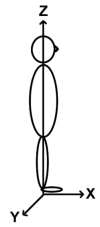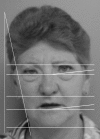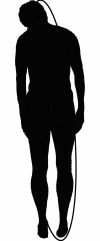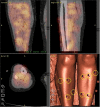A musculoskeletal model of low grade connective tissue inflammation in patients with thyroid associated ophthalmopathy (TAO): the WOMED concept of lateral tension and its general implications in disease
- PMID: 17319961
- PMCID: PMC1820789
- DOI: 10.1186/1471-2474-8-17
A musculoskeletal model of low grade connective tissue inflammation in patients with thyroid associated ophthalmopathy (TAO): the WOMED concept of lateral tension and its general implications in disease
Abstract
Background: Low level connective tissue inflammation has been proposed to play a role in thyroid associated ophthalmopathy (TAO). The aim of this study was to investigate this postulate by a musculoskeletal approach together with biochemical parameters.
Methods: 13 patients with TAO and 16 controls were examined. Erythrocyte levels of Zn, Cu, Ca2+, Mg, and Fe were determined. The musculoskeletal evaluation included observational data on body posture with emphasis on the orbit-head region. The angular foot position in the frontal plane was quantified following gait observation. The axial orientation of the legs and feet was evaluated in an unloaded supine position. Functional propioceptive tests based on stretch stimuli were done by using foot inversion and foot rotation.
Results: Alterations in the control group included neck tilt in 3 cases, asymmetrical foot angle during gait in 2, and a reaction to foot inversion in 5 cases. TAO patients presented facial asymmetry with displaced eye fissure inclination (mean 9.1 degrees) as well as tilted head-on-neck position (mean 5.7 degrees). A further asymmetry feature was external rotation of the legs and feet (mean 27 degrees). Both foot inversion as well as foot rotation induced a condition of neuromuscular deficit. This condition could be regulated by gentle acupressure either on the lateral abdomen or the lateral ankle at the acupuncture points gall bladder 26 or bladder 62, respectively. In 5 patients, foot rotation produced a phenomenon of moving toes in the contra lateral foot. In addition foot rotation was accompanied by an audible tendon snapping. Lower erythrocyte Zn levels and altered correlations between Ca2+, Mg, and Fe were found in TAO.
Conclusion: This whole body observational study has revealed axial deviations and body asymmetry as well as the phenomenon of moving toes in TAO. The most common finding was an arch-like displacement of the body, i.e. eccentric position, with foot inversion and head tilt to the contra lateral side and tendon snapping. We propose that eccentric muscle action over time can be the basis for a low grade inflammatory condition. The general implications of this model and its relations to Zn and Se will be discussed.
Figures


















Similar articles
-
3D-MRI rendering of the anatomical structures related to acupuncture points of the Dai mai, Yin qiao mai and Yang qiao mai meridians within the context of the WOMED concept of lateral tension: implications for musculoskeletal disease.BMC Musculoskelet Disord. 2007 Apr 10;8:33. doi: 10.1186/1471-2474-8-33. BMC Musculoskelet Disord. 2007. PMID: 17425796 Free PMC article.
-
Quantitative Analysis of Inflammation in Orbital Fat of Thyroid-associated Ophthalmopathy Using MRI Signal Intensity.Sci Rep. 2017 Dec 4;7(1):16874. doi: 10.1038/s41598-017-17257-6. Sci Rep. 2017. PMID: 29203853 Free PMC article.
-
[Clinical analysis of 403 cases of thyroid associated ophthalmopathy].Zhonghua Yan Ke Za Zhi. 2013 Aug;49(8):685-90. Zhonghua Yan Ke Za Zhi. 2013. PMID: 24246805 Chinese.
-
The diagnosis and treatment of thyroid-associated ophthalmopathy.Aesthetic Plast Surg. 2012 Jun;36(3):638-48. doi: 10.1007/s00266-011-9843-4. Epub 2011 Nov 16. Aesthetic Plast Surg. 2012. PMID: 22083413 Review.
-
Does the Interaction between Local and Systemic Inflammation Provide a Link from Psychology and Lifestyle to Tissue Health in Musculoskeletal Conditions?Int J Mol Sci. 2021 Jul 7;22(14):7299. doi: 10.3390/ijms22147299. Int J Mol Sci. 2021. PMID: 34298917 Free PMC article. Review.
Cited by
-
Practical Guidelines for Diagnosing and Treating Thyroid Disease Based on the WOMED Metabolic Model of Disease Focusing on Glycolysis and Coenzyme Q10 Deficiency-A Clinical Alternative to the 2021 Retired Clinical Practice Guidelines of the Endocrine Society.Diagnostics (Basel). 2022 Jan 4;12(1):107. doi: 10.3390/diagnostics12010107. Diagnostics (Basel). 2022. PMID: 35054274 Free PMC article.
-
The WOMED model of benign thyroid disease: Acquired magnesium deficiency due to physical and psychological stressors relates to dysfunction of oxidative phosphorylation.BBA Clin. 2014 Nov 12;3:44-64. doi: 10.1016/j.bbacli.2014.11.002. eCollection 2015 Jun. BBA Clin. 2014. PMID: 26675817 Free PMC article.
-
3D-MRI rendering of the anatomical structures related to acupuncture points of the Dai mai, Yin qiao mai and Yang qiao mai meridians within the context of the WOMED concept of lateral tension: implications for musculoskeletal disease.BMC Musculoskelet Disord. 2007 Apr 10;8:33. doi: 10.1186/1471-2474-8-33. BMC Musculoskelet Disord. 2007. PMID: 17425796 Free PMC article.
-
Applying a systems approach to thyroid physiology: Looking at the whole with a mitochondrial perspective instead of judging single TSH values or why we should know more about mitochondria to understand metabolism.BBA Clin. 2017 Apr 4;7:127-140. doi: 10.1016/j.bbacli.2017.03.004. eCollection 2017 Jun. BBA Clin. 2017. PMID: 28417080 Free PMC article. Review.
-
Proof of concept of the WOMED model of benign thyroid disease: Restitution of thyroid morphology after correction of physical and psychological stressors and magnesium supplementation.BBA Clin. 2014 Dec 31;3:113-22. doi: 10.1016/j.bbacli.2014.12.005. eCollection 2015 Jun. BBA Clin. 2014. PMID: 26672672 Free PMC article.
References
-
- Kiljanski J, Nebes V, Stachura I, Kennerdell JS, Wall JR. Should Graves' disease be considered a collagen disorder of the thyroid, skeletal muscle and connective tissue? Horm Metab Res. 1995;27:528–532. - PubMed
Publication types
MeSH terms
LinkOut - more resources
Full Text Sources
Medical
Miscellaneous

